Abstract
Intrathoracic (oesophageal), intra-abdominal (gastric), and transdiaphragmatic (Pdi) pressures were studied in 20 untrained, healthy subjects during a full inspiration and repeated maximal static inspiratory efforts. The pattern of pressure generation during these two types of respiratory manoeuvre was highly reproducible in each subject. By contrast, it varied over a wide range among individuals. In particular a substantial number of subjects naturally had a strong recruitment of their intercostal and accessory muscles and thus, low Pdi values, during both slowly performed and forceful inspiratory manoeuvres. These observations make it clear that Pdi values, as usually obtained, are commonly open to misinterpretation. For this approach to ensure a reliable assessment of diaphragmatic function and detect diaphragm weakness adequately, it appears essential either to monitor the abdominothoracic configuration or to standardise the pattern of respiratory muscle contraction.
Full text
PDF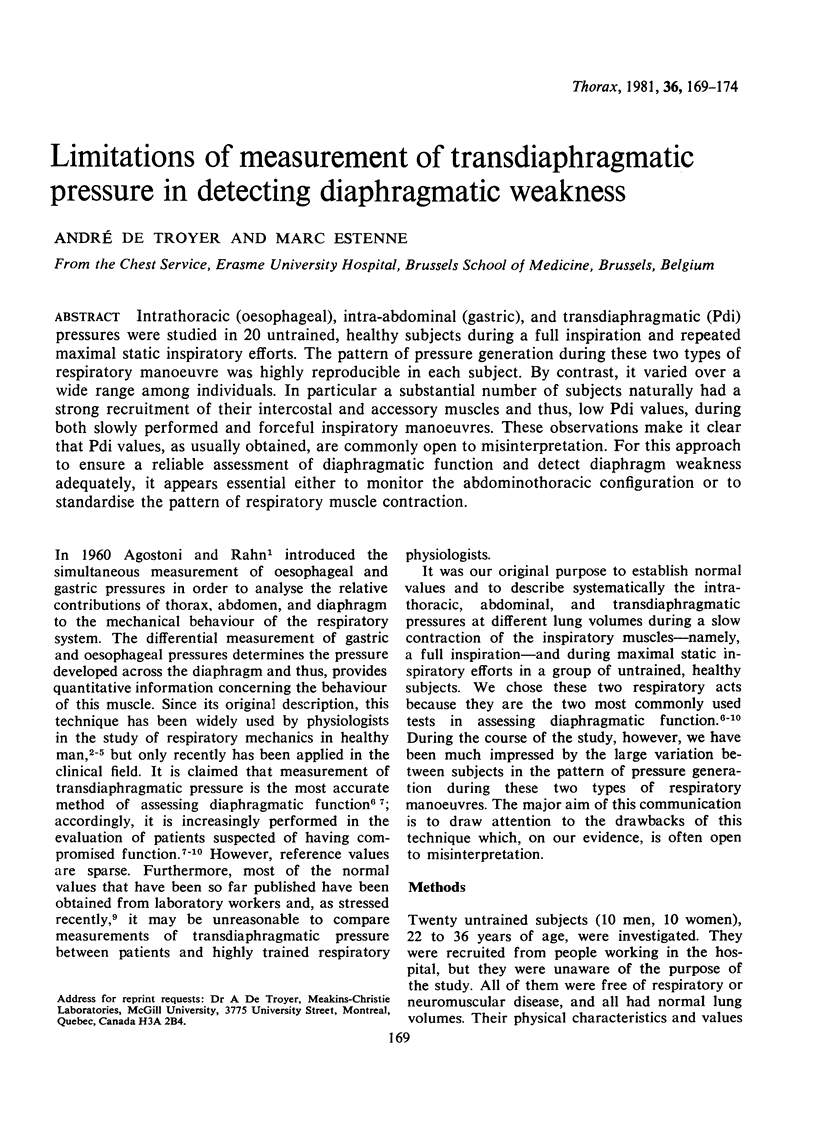
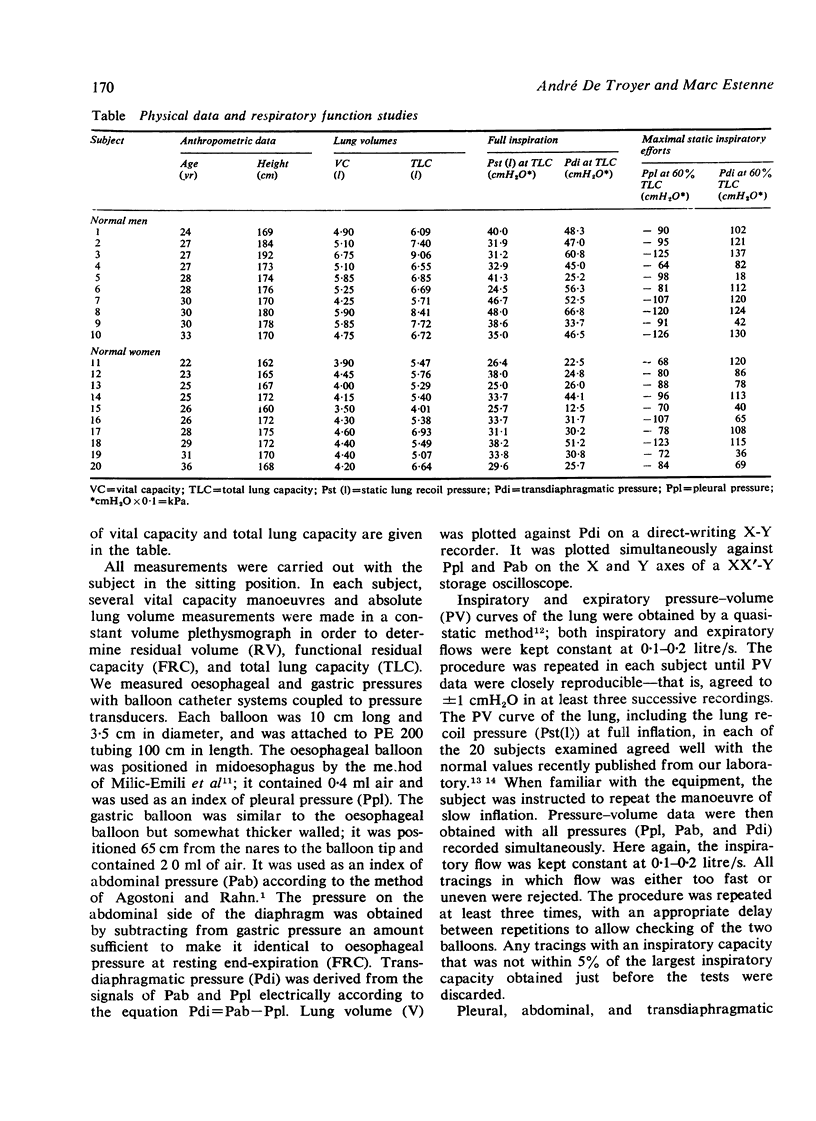
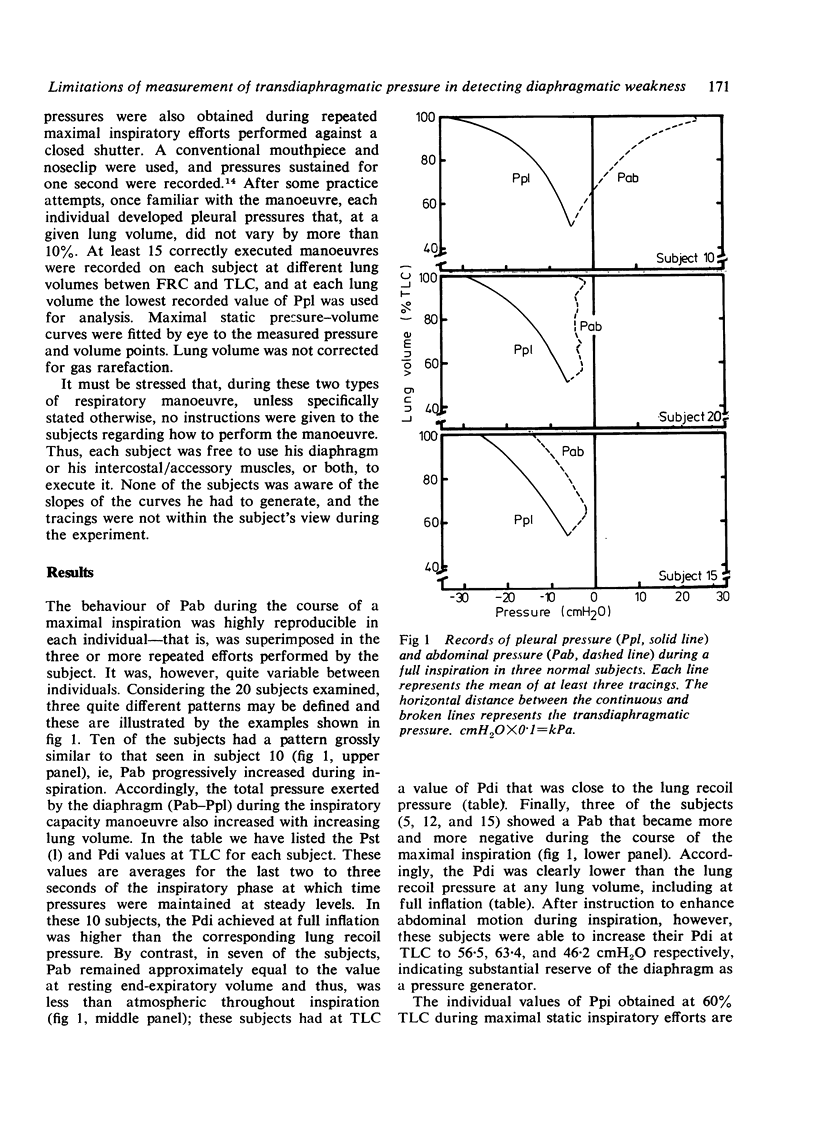
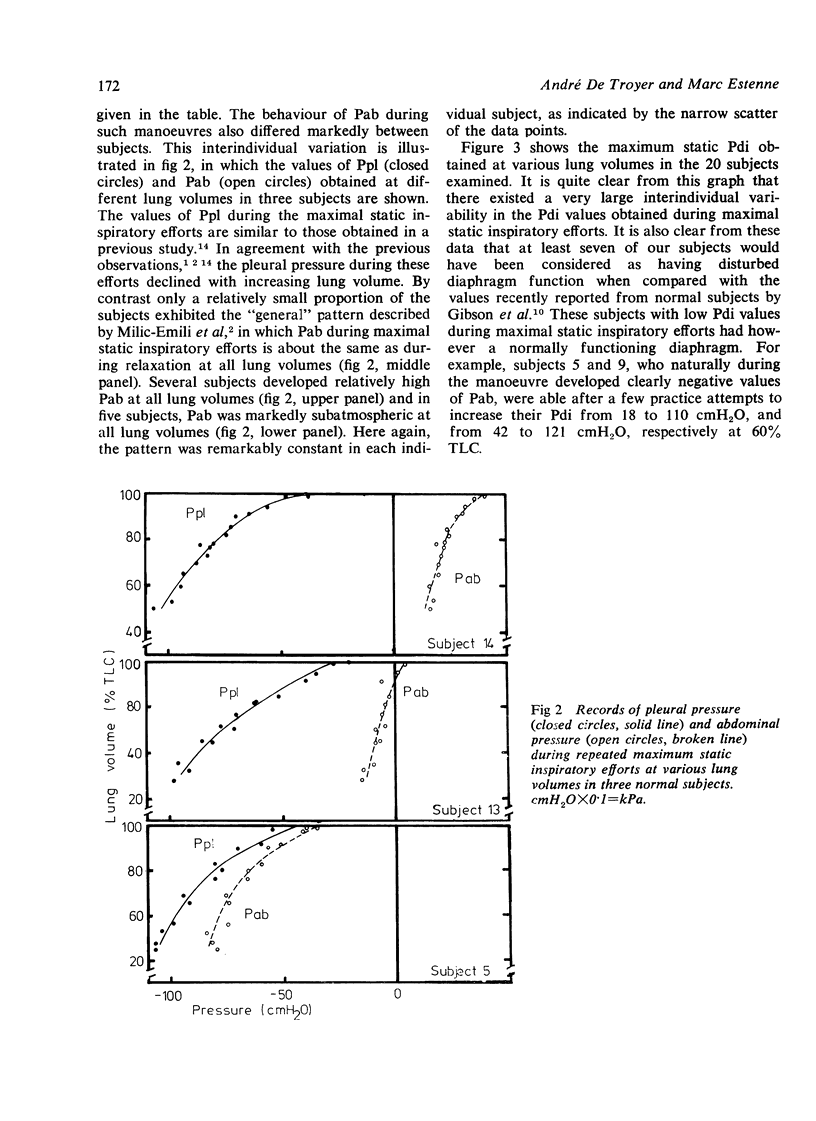
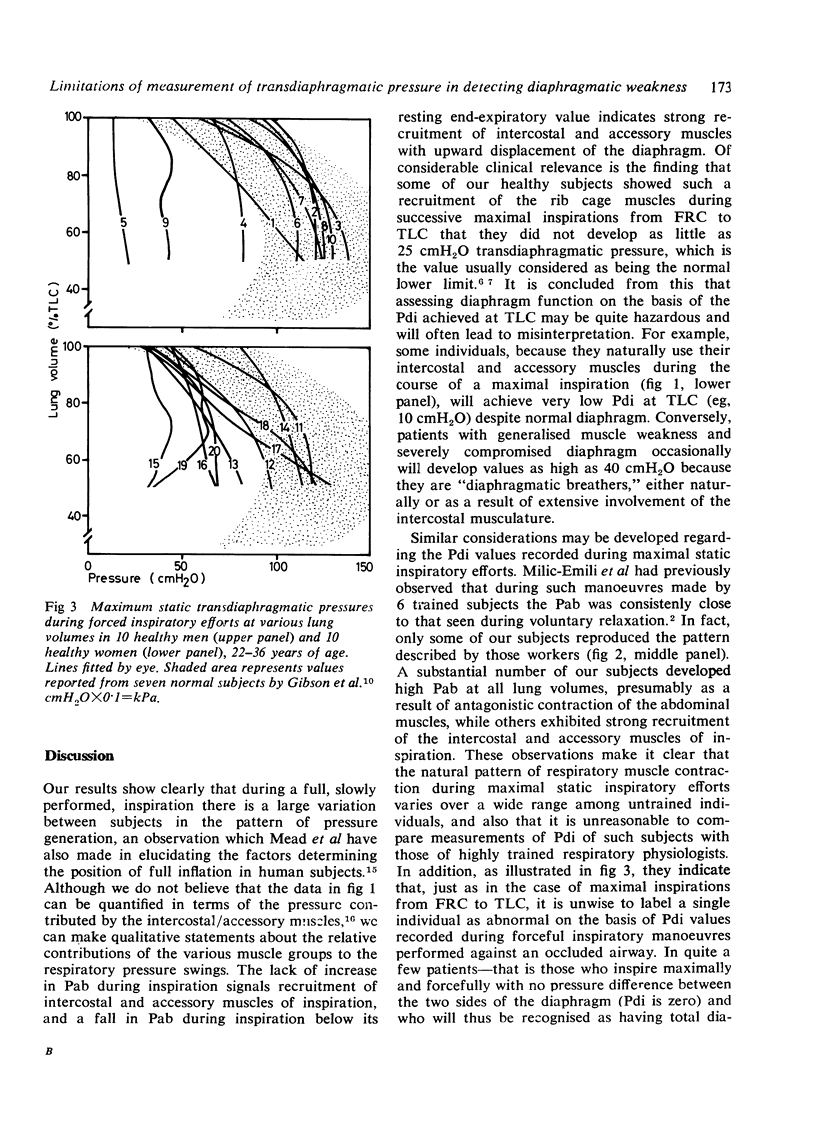
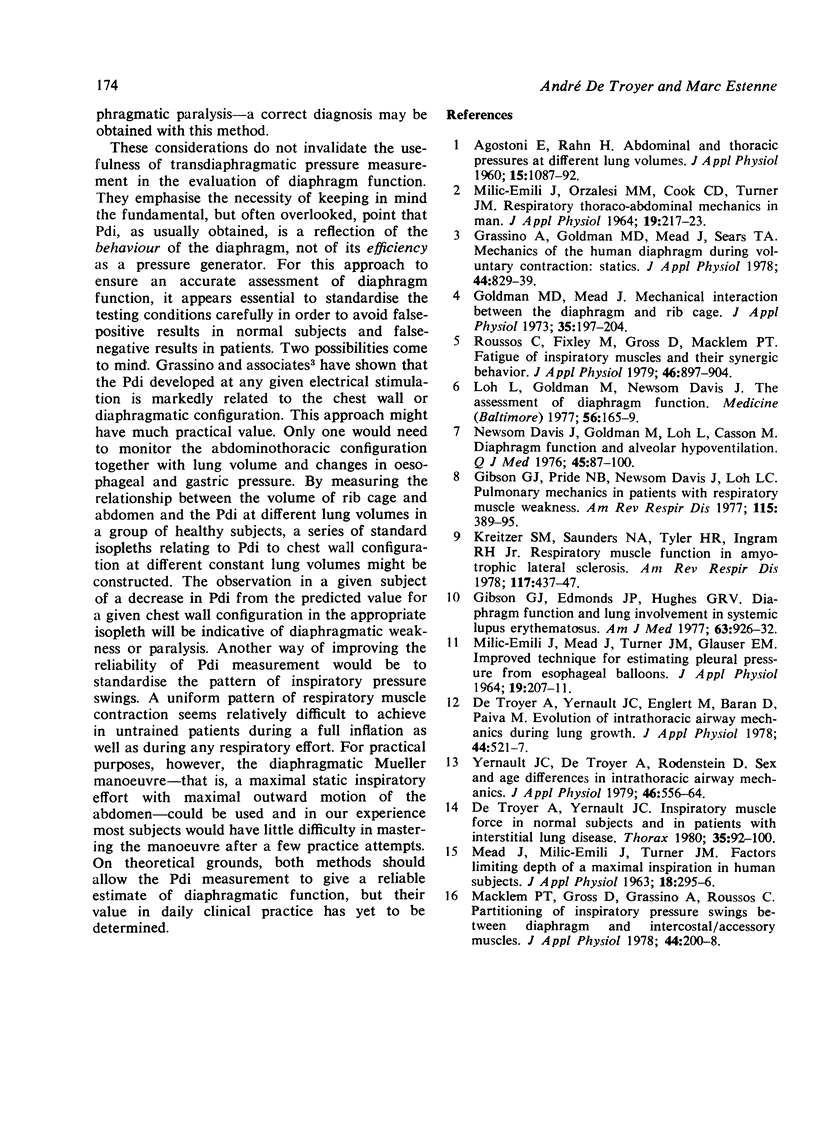
Selected References
These references are in PubMed. This may not be the complete list of references from this article.
- AGOSTONI E., RAHN H. Abdominal and thoracic pressures at different lung volumes. J Appl Physiol. 1960 Nov;15:1087–1092. doi: 10.1152/jappl.1960.15.6.1087. [DOI] [PubMed] [Google Scholar]
- Davis J., Goldman M., Loh L., Casson M. Diaphragm function and alveolar hypoventilation. Q J Med. 1976 Jan;45(177):87–100. [PubMed] [Google Scholar]
- De Troyer A., Yernault J. C., Englert M., Baran D., Paiva M. Evolution of intrathoracic airway mechanics during lung growth. J Appl Physiol Respir Environ Exerc Physiol. 1978 Apr;44(4):521–527. doi: 10.1152/jappl.1978.44.4.521. [DOI] [PubMed] [Google Scholar]
- Gibson C. J., Edmonds J. P., Hughes G. R. Diaphragm function and lung involvement in systemic lupus erythematosus. Am J Med. 1977 Dec;63(6):926–932. doi: 10.1016/0002-9343(77)90547-2. [DOI] [PubMed] [Google Scholar]
- Gibson G. J., Pride N. B., Davis J. N., Loh L. C. Pulmonary mechanics in patients with respiratory muscle weakness. Am Rev Respir Dis. 1977 Mar;115(3):389–395. doi: 10.1164/arrd.1977.115.3.389. [DOI] [PubMed] [Google Scholar]
- Goldman M. D., Mead J. Mechanical interaction between the diaphragm and rib cage. J Appl Physiol. 1973 Aug;35(2):197–204. doi: 10.1152/jappl.1973.35.2.197. [DOI] [PubMed] [Google Scholar]
- Grassino A., Goldman M. D., Mead J., Sears T. A. Mechanics of the human diaphragm during voluntary contraction: statics. J Appl Physiol Respir Environ Exerc Physiol. 1978 Jun;44(6):829–839. doi: 10.1152/jappl.1978.44.6.829. [DOI] [PubMed] [Google Scholar]
- Kreitzer S. M., Saunders N. A., Tyler H. R., Ingram R. H., Jr Respiratory muscle function in amyotrophic lateral sclerosis. Am Rev Respir Dis. 1978 Mar;117(3):437–447. doi: 10.1164/arrd.1978.117.3.437. [DOI] [PubMed] [Google Scholar]
- Loh L., Goldman M., Davis J. N. The assessment of diaphragm function. Medicine (Baltimore) 1977 Mar;56(2):165–169. doi: 10.1097/00005792-197703000-00006. [DOI] [PubMed] [Google Scholar]
- MEAD J., MILIC-EMILI J., TURNER J. M. Factors limiting depth of a maximal inspiration in human subjects. J Appl Physiol. 1963 Mar;18:295–296. doi: 10.1152/jappl.1963.18.2.295. [DOI] [PubMed] [Google Scholar]
- MILIC-EMILI J., MEAD J., TURNER J. M., GLAUSER E. M. IMPROVED TECHNIQUE FOR ESTIMATING PLEURAL PRESSURE FROM ESOPHAGEAL BALLOONS. J Appl Physiol. 1964 Mar;19:207–211. doi: 10.1152/jappl.1964.19.2.207. [DOI] [PubMed] [Google Scholar]
- MILIC-EMILI J., ORZALESI M. M., COOK C. D., TURNER J. M. RESPIRATORY THORACO-ABDOMINAL MECHANICS IN MAN. J Appl Physiol. 1964 Mar;19:217–223. doi: 10.1152/jappl.1964.19.2.217. [DOI] [PubMed] [Google Scholar]
- Macklem P. T., Gross D., Grassino G. A., Roussos C. Partitioning of inspiratory pressure swings between diaphragm and intercostal/accessory muscles. J Appl Physiol Respir Environ Exerc Physiol. 1978 Feb;44(2):200–208. doi: 10.1152/jappl.1978.44.2.200. [DOI] [PubMed] [Google Scholar]
- Roussos C., Fixley M., Gross D., Macklem P. T. Fatigue of inspiratory muscles and their synergic behavior. J Appl Physiol Respir Environ Exerc Physiol. 1979 May;46(5):897–904. doi: 10.1152/jappl.1979.46.5.897. [DOI] [PubMed] [Google Scholar]
- Yernault J. C., De Troyer A., Rodenstein D. Sex and age differences in intrathoracic airways mechanics in normal man. J Appl Physiol Respir Environ Exerc Physiol. 1979 Mar;46(3):556–564. doi: 10.1152/jappl.1979.46.3.556. [DOI] [PubMed] [Google Scholar]
- de Troyer A., Yernault J. C. Inspiratory muscle force in normal subjects and patients with interstitial lung disease. Thorax. 1980 Feb;35(2):92–100. doi: 10.1136/thx.35.2.92. [DOI] [PMC free article] [PubMed] [Google Scholar]


